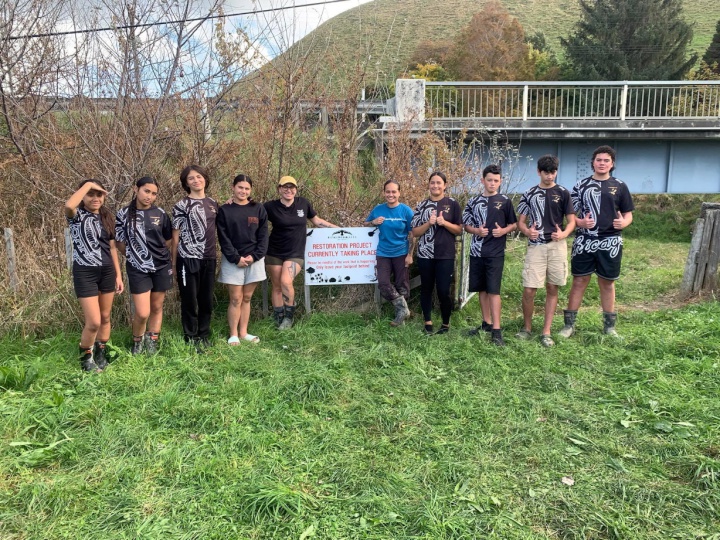Connecting Back To Their Whenua
Being part of the mahi (work) in the natural environment (taiao) shows young tauira (students) the job possibilities they could be involved in.

Tara Whaanga (left of sign) and Shaavone Brown (right of sign) from Te Ngahuru Tikotikoiere team from Rongowhakaata Iwi Trust with tauira from Te Kura o Manutuke.
Te Ngahuru Tikotikoiere team from Rongowhakaata Iwi Trust took a class from Te Kura o Manutuke to one of their inanga monitoring and restoration sites recently.
Inanga is a native fish species whose abundance and habitat have been the focus of improvement by the team in partnership with Gisborne District Council.
Council Environmental Scientist Isabella Clere is leading the project and says this year’s spawning season has been very successful.
“There’s been an abundance of inanga eggs found at one of the monitoring sites, as well as eggs found at a new monitoring site which is very encouraging.”
The Manutuke School tauira took part in a range of activities to do with inanga.
Tara Whaanga, from Te Ngahuru Tikotikoiere team, says engaging with the community and doing educational outreach about inanga and the importance of their habitat, is one of the aims of this project.
“We wanted to plant the seed for the tauira by getting them involved in activities needed to monitor and support the inanga spawning in our rivers and streams.
“This gives them an insight and wider view into the mahi opportunities they can get involved with in the future.”
“The students also whakapapa to the inanga sites the team is monitoring and restoring, so being able to connect them with their whenua is very meaningful for me and Shaavone.”
Shaavone Brown, who is also on the team, says minnow traps were set the evening before so the students could see what critters were living in the stream.
“The next day they found inanga and freshwater koura (crayfish).”
Shaavone says an artificial inanga spawning habitat was created using coconut fibre, pea straw and harakeke woven together.
“After the habitat was assembled, we chose a location based on where the inanga is most likely to spawn along a stream.
“They then got their waders on and got stuck into the mahi. It was amazing to see the tauira getting involved in our taiao and they were eager to learn about the mahi.”
The team also did an eDNA test at the stream which identifies the range of species living in and using that stream.
Te Ngahuru Tikotikoiere team from Rongowhakaata Iwi Trust has been working in partnership with Council since 2021 to monitor inanga spawning and restore the habitat of spawning sites.
Ko au te Taiao, ko te Taiao ko au
I am the Taiao, and the Taiao is me.


 Gordon Campbell: On The Hikoi Aftermath
Gordon Campbell: On The Hikoi Aftermath Free Speech Union: Fair Digital News Bargaining Bill Likely To Restrict Access To Information, Polling Shows Most Oppose
Free Speech Union: Fair Digital News Bargaining Bill Likely To Restrict Access To Information, Polling Shows Most Oppose Auckland Transport: Driver Safety Screens Now Rolling Out Across Auckland’s Bus Fleet
Auckland Transport: Driver Safety Screens Now Rolling Out Across Auckland’s Bus Fleet People Against Prisons Aotearoa: 'Expect Resistance' - Community Group Pushes Back Against More Cops With Guns
People Against Prisons Aotearoa: 'Expect Resistance' - Community Group Pushes Back Against More Cops With Guns Greenpeace: New Zealand Drops In Global Ranking On Climate Action
Greenpeace: New Zealand Drops In Global Ranking On Climate Action PSA: Spending Cuts Need To Stop - PSA Urges Govt To Listen To Economists
PSA: Spending Cuts Need To Stop - PSA Urges Govt To Listen To Economists Stats NZ: National Population Estimates: At 30 September 2024 (2018-base)
Stats NZ: National Population Estimates: At 30 September 2024 (2018-base)


